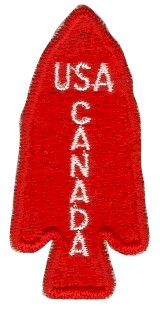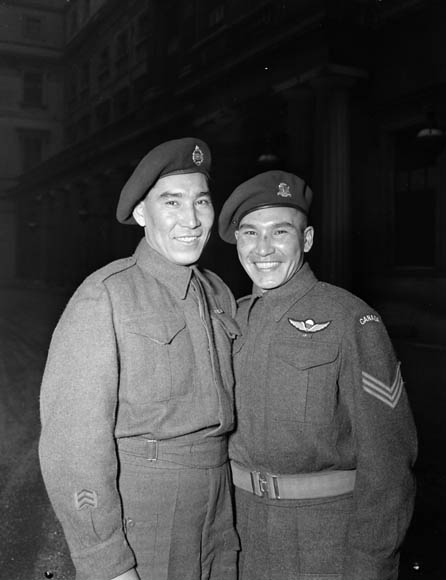Tommy Prince was born on October 15th, 1915, in Scanterbury Manitoba Canada in a family of eleven siblings. He left school at an early age (8th grade) and followed his father in his hunting expeditions around the Indian reserve, and was thus able to provide a meal for his younger siblings.
At the time, hunting was just a means to put food on the table; little did he know that it would come in handy during his career as a soldier. He later joined the cadets as a teenager, where he perfected his rifle handling skills until he could easily put five bullets on a small target. He is often described as a quiet man whose moves were always well calculated.
In 1939 at the onset of World War II in Europe, Tommy Prince volunteered to fight for the Canadian Army but was turned down multiple times until he was finally accepted in 1940 in the Royal Canadian Engineers. He trained here for two years and later joined the paratrooper service and after enduring rigorous training, he was among the few people who were sent to join the parachute school in Manchester, England.
Due to his earlier acquired hunting and tracking skills, he excelled at the parachute school and was promoted to Lance Corporal. He returned to Canada in 1942 and joined the Canadian Parachute Battalion, where he was made a sergeant. This Canadian unit joined forces with the US Special Force, to form the 1st Special Service Force.

The first mission of the First Special Service Force was in January 1943, to fight the Japanese in the Pacific when they had invaded an island known as Kiska, but they did not even have to put up a fight because, by the time they reached the island, the Japanese had already withdrawn.
Later, Tommy Prince with the First Special Service Force was sent on some missions and his commanders noticed his exemplary tracking skills and made him a reconnaissance sergeant. Whenever the team wanted to make an attack, Tommy Prince would be sent to track enemy positions and describe the surrounding landscape. However, it was during the Italian mission when they were fighting for the liberation of Rome, that Tommy Prince would shock everyone when his bravado far outshone what you usually see in films.
It was on February 8th, 1944, and the Special Force was engaged in a furious battle with the German Nazis for three months continuously. He volunteered for a solo reconnaissance mission to the enemy lines and hid in a farmhouse from where he would provide information about the enemy whereabouts and their movements. The information would be radioed back to the Allies using a 1,500-meter transmission cable. The information he sent back ensured that the Allied forces hit enemy targets accurately, destroying four key enemy positions.
During a rapid-fire exchange between the two forces, Tommy Prince’s communication with his team was interrupted, and he knew that the transmission cable had been tampered with. This is where he pulled one of the bravest moves of his career.

Tommy Prince got rid of his military uniform and put on rugged farmer’s attire which he found in the abandoned farmhouse. He disguised himself as a farmer, and ventured into German occupied territory, pretending that he was working on the farm. Armed with only a hoe, it was difficult for the Nazis to distinguish him and other Italian farmers, and he was thus able to spot where the cable had been cut. He pretended that he was tying his shoe, and repaired the damaged cable.
Afterward, he returned to the farmhouse which was his observation post and continued to provide enemy positions. So accurate were the targets he provided to the Allied forces, that within a short time the Germans were forced to withdraw. When he returned, Lieutenant-Colonel Gilday recommended Tommy Prince for a medal for, “exceptional bravery in the field.”
After the liberation of Rome, the Special Service Force was sent to Southern France. At one time when he was on his way back from a reconnaissance mission, he and a private were caught in a fierce battle between the French forces and the Nazis. They took up a position and started shooting at the Germans, taking out so many of them that the rest had to withdraw.
The French commander was shocked to realize that it was just Tommy Prince and a Private who were behind the forced German retreat; because he thought the rapid fire was coming from a group of fifty Allied soldiers. He was impressed by Prince’s bravery, and recommended him for a medal, the Croix de Guerre, but the message never reached the French Commander-in-Chief because the commander was killed en-route.
Tommy Prince is usually described as a weird yet entertaining character. His colleagues knew that he used to carry a pair of moccasins in his bag, and during the night he would take off his boots and wear the moccasins. He was thus able to creep quietly into the enemy camp, and sometimes he would do crazy things like stealing the Germans’ shoes.
Other times he would go with a few of his colleagues, and they would apply shoe polish to their faces, then creep into the German station at night and slit the throat of every third German soldier when they were sleeping. In the morning, the Germans would wake up to find their colleagues dead, plus missing shoes and this would totally freak them out. The Germans thus nicknamed the Special Force Service as the ‘Devil’s Brigade.’
Tommy Prince was awarded some of the most distinguished medals during his career as a soldier, including the US Silver Star. He served in various military positions until September 1954 when he was respectfully discharged, due to Arthritis in his knees. He died on November 1977, at the age of 62.
